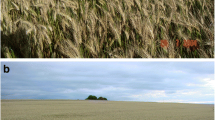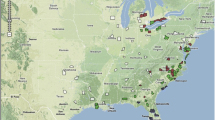Abstract
The temporal and regional distributions of the potential number of infection events of the exotic disease sorghum downy mildew in Australia were predicted for the years 1957–1998. A set of rules based on overseas research on the influence of environmental factors on infection and sporulation was used to interrogate daily climatic data from 1957 to 1998 for 53 selected localities. Between November and February, sorghum was at arelatively low risk of infection from downy mildew, with the risk gradually increasing during the summer, reaching the greatest risk in May for most localities. During March to May there were geographical south-north, as well as west-east, increasing gradients of predicted downy mildew events in Queensland and New South Wales. In winter and early spring, the analysis indicated that disease would occur only in the coastal regions of Queensland, with serious implications for breeders’ nurseries in these areas. The temporal and regional distributions of events were closely related to those of relative humidity, night temperature and night length. Sorghum downy mildew was predicated to be a minor problem in most part of New South Wales.
Similar content being viewed by others
References
Bock, C.H. and Jeger, M.J. (1996) — Downy mildew of sorghum. International Sorghum and Millets Newsletter 37: 33–51.
Bock, C.H., Jeger, M.J., Mughogho, L.K., Cardwell, K.F. and Mtisi, E. (1999) — Effect of dew point temperature and conidium age on germination, germ tube growth and infection of maize and sorghum by Peronosclerospora sorghi. Mycological Research 103: 859–864.
Bonde, M.R., Peterson, G.L. and Duck, N.B. (1985) — Effects of temperature on sporulation, conidial germination, and infection of maize by Peronosclerospora sorghi from different geographic areas. Phytopathology 75: 122–126.
Bonde, M.R., Schmitt, C.G. and Dapper, R. W. (1978) — Effects of dew-period temperature on germination of conidia and systemic infection of maize by Sclerospora sorghi. Phytopathology 68: 219–222.
Commonwealth Mycological Institute (1988) — Peronosclerospora sorghi (Weston & Uppal) C.G. Shaw. Commonwealth Mycological Institute Distribution Maps of Plant Diseases No. 179.
Craig, J. (1986) — Sorghum Downy Mildew. In Compendium of Sorghum Diseases. (Ed R.A Frederiksen), pp. 25–26. American Phytopathology Society, St. Paul, MN. U.S.A.
Goudriaan, J. and van Laar, H.H. (1994) — Modelling Potential Crop Growth Processes — Textbook With Exercises. Kluwer Academic Publishers, Dordrecht, The Netherlands.
Frederikson, R.A. (1980) — Sorghum downy mildew in the United States — overview and outlook. Plant Disease 64: 903–908.
Frederikson, R.A., Bockholt, A.J., Clark, L.E., Cosper, J.W., Craig, J., Johnson, J.W., Jones, B.L., Matocha, P., Miller, F.R., Reyes, L., Rosenow, D.T., Tuleen, D. and Walker, H.J. (1973) — Sorghum Downy Mildew — A Disease of Maize and Sorghum. Research Monograph 2, The Texas Agricultural Experiment Station, Texas A&M University.
McGee, D.C. (1992) — Principles and criteria of seed transmission of sorghum pathogens. In Sorghum and Millets Diseases: a Second World Review (Eds W.A.J. de Milliano, R.A. Frederiksen, and G.D. Bengston), pp. 297–302. International Crops Research Institute for Semi-Arid Tropics, Patancheru, India.
Meinke, H. and Ryley, M. (1997) — Effects of sorghum ergot on grain sorghum production: a preliminary climatic analysis. Australian Journal of Agricultural Research 48: 1241–1247.
Parton, W.J. and Logan, J.A. (1981) — A model for diurnal variation in soil and air temperature. Agricultural Meteorology 23: 205–216.
Rajasab, A.H., Shenoi, M.M. and Ramalingam, A.H. (1980) — Epidemiology of sorghum downy mildew (V). Incidence of systemic infection. Proceedings of the Indian National Science Academy, Part B 46: 552–561.
Ramsey, M.D. and Jones, D.R. (1988) — Peronosclerospora maydis found on maize, sweetcorn and plume sorghum in Far North Queensland. Plant Pathology 37: 581–587.
Schuh, W., Jeger, M.J. and Frederiksen R.A. (1987) — The influence of soil temperature, soil moisture, soil texture, and inoculum density on the incidence of sorghum downy mildew. Phytopathology 77: 125–128.
Shetty, H.S. and Safeeulla, K.M. (1981) — Effect of some environmental factors on the asexual phase of Peronosclerospora sorghi. Proceedings of the Indian Academy of Science (Plant Sciences) 90: 45–51.
Shivas, R.G. (1989) — Fungal and bacterial diseases of plants in Western Australia. Proceedings of the Royal Society of Western Australia 72: 1–62.
Stone, R.C., Hammer, G.L. and Marcussen, T. (1996) — Prediction of global rainfall probabilities using phases of the Southern Oscillation Index. Nature 384: 252–255.
Author information
Authors and Affiliations
Corresponding author
Rights and permissions
About this article
Cite this article
Wang, E., Ryley, M. & Meinke, H. Prediction of sorghum downy mildew risk in Australia using daily weather data. Australasian Plant Pathology 29, 108–119 (2000). https://doi.org/10.1071/AP00019
Received:
Accepted:
Issue Date:
DOI: https://doi.org/10.1071/AP00019




